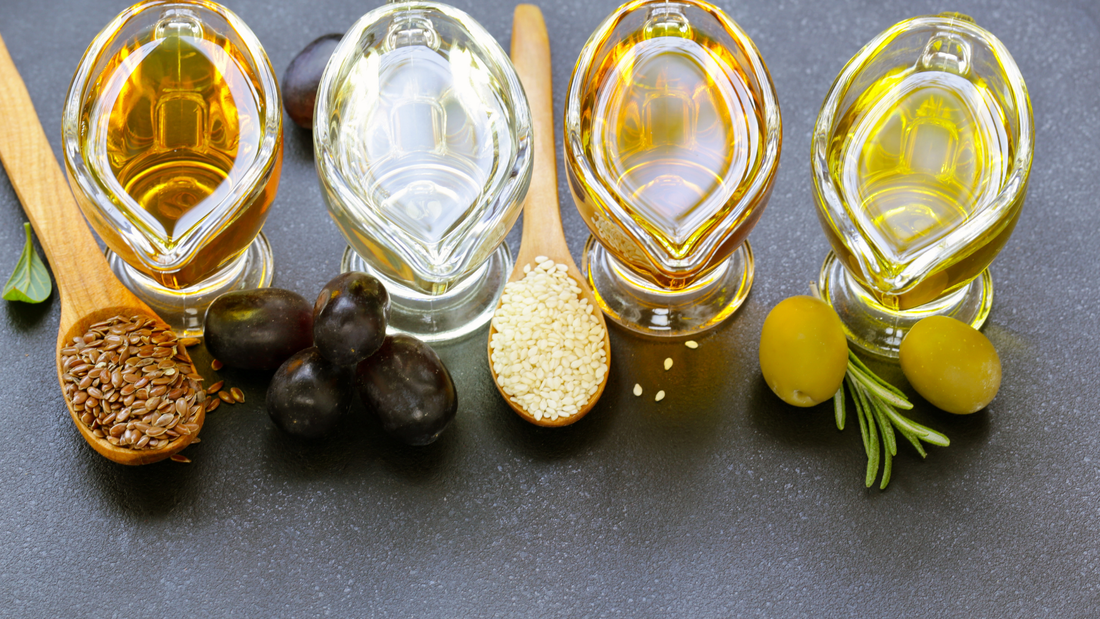
A Guide To Choosing Healthy Cooking Oils
Naturally YoursShare

Cooking oils are an integral part of diet and cooking.
Our Indian preparations involve various cooking methods like seasoning, tadka, frying, sauteing and tempering dishes with oils that enhances the flavour of food. The oil is also exposed, to different temperatures during cooking.
Are you curious to know which oil is best suitable for your cooking?
More and more options are available for the selection of oils. Still, people are confused regarding their benefits and usage.
Remember, no one size fits all – This quote best suits, when it comes to cooking oils and its preparations.
Some oils are better suited for frying while others for salad dressings. On the other hand, different oils have a different composition with distinct health benefits.
Therefore, the right selection of cooking oils is vital to impart their health benefits.
This article simplifies, which oil to use regularly and which to use sparingly.
Which oil is good for cooking?
It is ideal to maintain a balance of different fatty acids on a daily basis.
Therefore, changing the type of oil monthly is not enough. Using at least two different types of oils daily for various cooking purpose is recommended.
For example, mustard and rice bran oil; sunflower oil and soybean oil etc. National Institute of Nutrition (NIN) also recommends a combination or blending of oils.
Health tip: There is no single oil which is best or worst. Using one type of oil may not fulfil the requirement of all fatty acids. Therefore, it is recommended to use oils in rotation.
What about the health claims?

Many edible oils are marketed with claims as heart healthy, heart friendly, cholesterol free, cholesterol friendly etc.
You must remember 2 basic principles that all oils of vegetable origin are naturally cholesterol free. So, don't buy oil labelled as 'cholesterol-free' at higher cost compared to regular oil.
Even if you buy any type of oil or blended oil claiming 'heart friendly', it is unlikely to impart health benefits unless it is used in right amount with proper cooking method and temperature.
Health tip: It is recommended to use 500 ml oil per person per month (4 teaspoon per person per day).
Can cooking oils be reused after frying?

Repeated use of oils especially after frying leads to changes in the chemical composition of the oil.
Reusing of oils is linked with various types of cancers, heart disease and acidity. Because every time you heat oil, its goodness will deteriorate.
What can be done with the oil left-over after frying:
- If the oil is left over after frying, allow the oil to cool completely.
- Strain the leftover oil with fine mesh strainer or cloth to remove the leftover particles of fried food in the oil.
- Transfer the strained oil in a clean small container (not the one with fresh oil).
- Store it in cool and dry place.
- Before re-using it, remember that the oil catches the flavour of the food which was fried in it. So, use for similarly flavoured dishes.
- Do not use this oil for frying again but use it for sautéing veggies on low flame or for tempering.
Health tip: It’s advisable to reuse the fried oil after 2 fries, for different cooking purposes (seasoning/tadka). If the colour of the oil changes (brown) it’s safe to discard the oil.
How about storage/Uses of cooking oils?
Appropriate storage of cooking oil is important to retain its freshness, flavour and quality.
There are three factors which can deteriorate the quality of oil - light, oxygen and temperature.
When stored in a cool and dark place, cooking oils last for around 3 to 6 months, especially, if the packing is opened.
Oils in unopened packs can remain good for more months.
|
Type of oil |
Uses |
|
Sunflower oil |
frying, tempering, roasting |
|
Mustard oil |
frying, tempering, roasting, pickles |
|
Coconut oil |
frying, tempering, baking |
|
Sesame oil |
Stir-frying, sauteing, pickles |
|
Groundnut oil |
All purpose- deep frying, deep frying, tempering |
|
Soybean oil |
Frying, roasting, baking |
|
Rice bran oil |
frying, tempering |
What is cold-pressed oil?
This is a minimal processing method where oil retains its original colour, flavour and most of the nutrients.
Cold pressed oils also retain phytochemicals and antioxidants like vitamin E. In this method the temperature while pressing is cautiously maintained at room temperature and the oil is extracted from the seeds at that low temperature itself.
Example: Coconut oil, Soybean oil, Groundnut oil, Sesame oil, etc.
Most oils are not suitable for the cold pressed method as many unwanted residues and traces can be found in the oil giving it a bitter taste, dark colour and strong odour.
Health tip: Cold pressed oils are nutritious when compared to refined oils, but shelf life is lesser.
What is meant by blending of oils?
Blending of oils is done with the intention of combining good properties of two or more different oils together to obtain the maximum benefits of both the oils.
But blending of oils cannot be used for high temperature cooking as the smoking point of oils differ, one of the oils from blended oil may achieve its smoking point earlier and other can start degrading.
Health tip: Blended oils should be used for low temperature cooking and not for frying.
Oily Glimpse:
In a nutshell, cooking oils used in proper quantity, combination, and appropriate temperature with recommended storage and caution can impart various health benefits.
Use a variety of cooking oils to reap maximum benefits such as nutritional value and flavour.
ABOUT THE AUTHOR

Indu Vaishnavi R, Dietician
